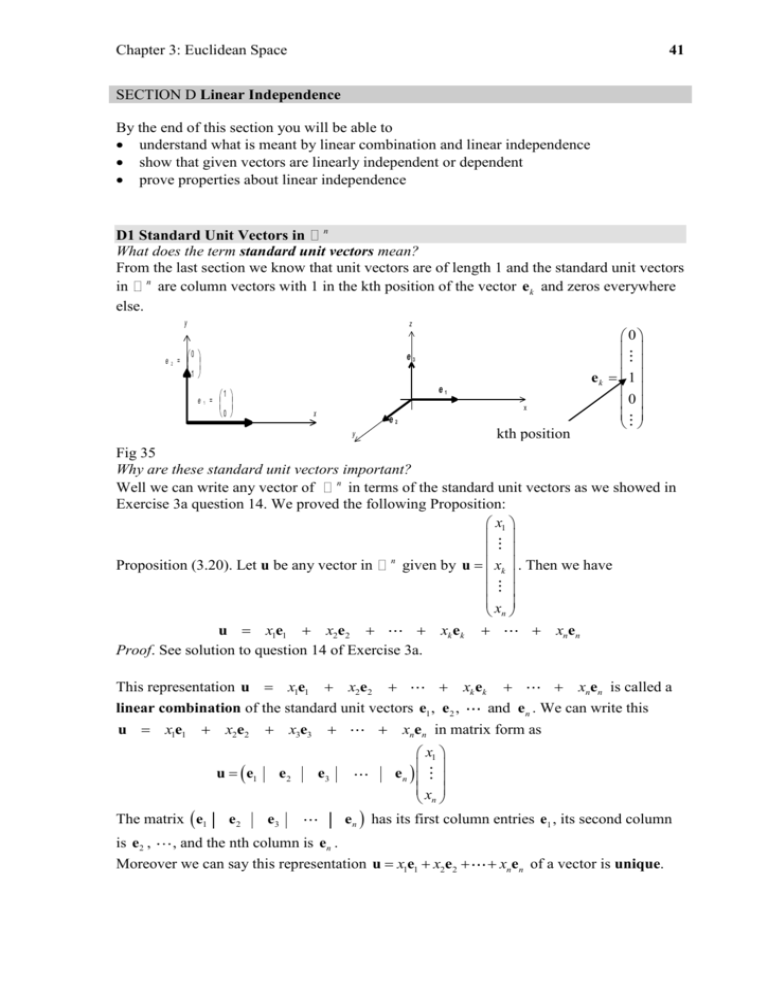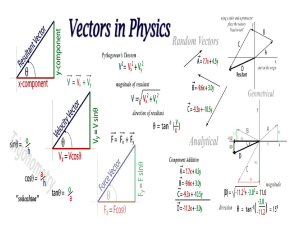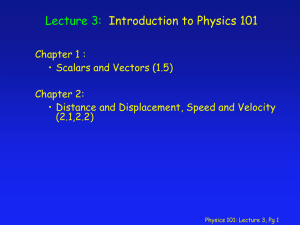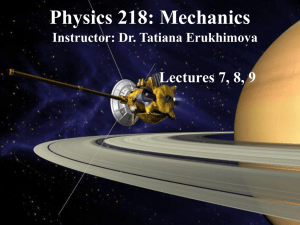SECTION D Linear Independence
advertisement

Chapter 3: Euclidean Space
41
SECTION D Linear Independence
By the end of this section you will be able to
understand what is meant by linear combination and linear independence
show that given vectors are linearly independent or dependent
prove properties about linear independence
D1 Standard Unit Vectors in n
What does the term standard unit vectors mean?
From the last section we know that unit vectors are of length 1 and the standard unit vectors
in n are column vectors with 1 in the kth position of the vector ek and zeros everywhere
else.
y
e2 =
z
0
1
e1 =
e3
e1
1
0
x
x
e2
kth position
y
0
ek 1
0
Fig 35
Why are these standard unit vectors important?
Well we can write any vector of n in terms of the standard unit vectors as we showed in
Exercise 3a question 14. We proved the following Proposition:
x1
Proposition (3.20). Let u be any vector in n given by u xk . Then we have
x
n
u x1e1 x2e2
xk ek
xnen
Proof. See solution to question 14 of Exercise 3a.
xk ek
xnen is called a
This representation u x1e1 x2e2
and en . We can write this
linear combination of the standard unit vectors e1 , e2 ,
u x1e1 x2e2 x3e3
xnen in matrix form as
u e1
The matrix e1
e2
e2
e3
e3
en
x1
en
x
n
has its first column entries e1 , its second column
is e2 , , and the nth column is en .
Moreover we can say this representation u x1e1 x2e2
xnen of a vector is unique.
Chapter 3: Euclidean Space
42
Proposition (3.21). Let u be any vector in n then the linear combination
u x1e1 x2e2
xk ek
xnen
is unique.
What does this proposition mean?
Means that there is only one way of writing any vector u of n in terms of the standard
unit vectors e1 , e2 ,
and en .
Proof.
Let the vector u be written as another linear combination:
u y1e1 y2e2
yk ek
ynen
What do we need to show?
Required to show that the scalars are equal: y1 x1 , y2 x2 , y3 x3 ,
and yn xn .
Equate the two linear combinations because both are equal to u:
x1e1 x2e2
xnen y1e1 y2e2
yn e n
x1e1 x2e2
x1 y1 e1
xnen
x2 y2 e2
Writing out e1 , e2 ,
y1e1
y2e2
xn yn en
yn e n O
O
Factorising
, en and O as column vectors in the last line we have
1
0
0 0
0
0
1
0 0
Remember ek
x1 y1 x2 y2 xn yn
1
0
0
1 0
0
We can write this in matrix form as
0 x1 y1 0
x1 y1 0
1 0
I is the
x y
x
y
0
1
0
0
0
2
2
2
2
identity
implies I
0
matrix
1 xn yn 0
0
xn yn 0
and xn yn 0 which gives our
Hence we have x1 y1 0, x2 y2 0, x3 y3 0,
and yn xn .
result: y1 x1 , y2 x2 , y3 x3 ,
Therefore the given linear combination, u x1e1 x2e2 xk ek xnen , is unique. ■
D2 Linear Independence
Example 12
Determine the linear combination of the standard unit vectors in n which gives the zero
and xn in the following:
vector. This means find the values of the scalars x1 , x2 , x3 ,
x1e1 x2e2
xk ek
xnen O
Solution
and en we have
Substituting e1 , e2 ,
1
0
0
1
x1 x2
0
0
0 0
0
0
xn
1 0
Chapter 3: Euclidean Space
43
We can write this in matrix form as
1
0 x1 0
[This is Ix O ]
1 xn 0
0
In compact form we have Ix O where I is the identity matrix. Ix O gives x O .
From the zero vector x O we have x1 0, x2 0, x3 0,
and xn 0 .
We say that the standard unit vectors e1 , e2 ,
and en are linearly independent which
means that any one of the vectors ek cannot be made by a linear combination of the others.
These standard unit vectors are not the only vectors in
Definition (3.22). Generally we say vectors v1 , v 2 , v3 ,
n
which are linearly independent.
and v n in n are linearly
independent the only real scalars k1 , k2 , k3 ,
and kn which satisfy:
k1v1 k2 v 2 k3 v3 kn v n O are k1 k2 k3 kn 0
What does this mean?
The only solution to the linear combination k1v1 k2 v 2
kn v n O is
when all the scalars k1 , k2 , k3 ,
and kn are equal to zero. In other words you cannot
make any one of the vectors v j say, by a linear combination of the others.
We can write the linear combination k1v1 k2 v 2 k3 v3
v
1
v2
The first column of the matrix v1
v3
v2
v3
kn v n O in matrix form as
k1 0
k
0
vn 2
kn 0
v n is given by the entries in v1 ,
the second column is given by the entries in v 2 and the nth column is given by the entries
in v n .
Recall from chapters 1 and 2 that a linear system Ax O has the unique solution x 0
matrix A is invertible or det A 0 [Not zero].
How is this related to linear independence?
v n then these vectors v1 , v 2 , … and v n are
Well if the matrix A v1 v 2
linearly independent Ax O has the unique solution x O . What does this mean?
v n is invertible or
Means we only need to check that the matrix A v1 v 2
det A 0 [not zero] for the vectors v1 , v 2 , … and v n to be linearly independent.
Example 13
1
2
Show that u and v are linearly independent in 2 and plot them.
1
3
Solution
Using the above definition (3.22) and writing out the linear combination we have
k u c v O [Using k and c as scalars]
Substituting the given vectors u and v into this k u c v O gives
Chapter 3: Euclidean Space
44
k 2c 0
1 2 0
k c or
k 3c 0
1 3 0
1 2
k
0
Let A u
v
and x . We need to solve Ax O where O .
1 3
c
0
1 2
Since det A det
1 3 1 2 5 is non-zero so the only solution is
1 3
x O [Because Ax O and det A 0 then x O ] which means the values of the
scalars are k 0 and c 0 .
Hence the linear combination k u c v O yields k 0 and c 0 therefore the
given vectors u and v are linearly independent because all the scalars, k and c, are equal
to zero. Plotting the given vectors we have:
2
v
3
1
u
1
Fig 36
This means that vector u is not a scalar multiple of vector v and vice-versa.
In 2 the vectors u and v are linearly independent means that they are not scalar multiples
of each other. Plotting linear independent vectors:
v
Linearly independent vectors u
and v
u
Fig 37
D3 Linear Dependence
What does linear dependence mean?
Definition (3.23). Conversely we have the vectors v1 , v 2 , v3 ,
linearly dependent the scalars k1 , k2 , k3 ,
k1v1 k2 v 2 k3 v3
and v n in
n
are
and kn are not all zero and satisfy
kn v n O
From chapters 1 and 2 we know that the linear system
Ax O
has an infinite number of solutions if det A 0 . This means that if
k1
A v1 v2
vn , x
k
n
and v n are linearly dependent. Why?
and det A 0 then these vectors v1 , v 2 , v3 ,
Because det A 0 means the linear system Ax O has an infinite number of solutions
so there must be non-zero solutions, that is x O . Hence there are non-zero k’s which
satisfy
Chapter 3: Euclidean Space
45
k1v1 k2 v 2 k3 v3
kn v n O
Example 14
3
1
2
Show that u and v
and plot them.
are linearly dependent in
1
1/ 3
Solution
Using the above definition (3.23) and writing the vectors u and v as a linear combination
we have
k u c v O [k and c are scalars]
Substituting the given vectors
3 1 0
ku cv k c
1 1/ 3 0
You can check the determinant of A u
v is equal to zero. However this does not
give us the relationship between the two vectors u and v. We can write out the argumented
O and carry out row operations to determine the relationship between u and
matrix A
v. The augmented matrix for this is given by
R1 3 1
0
Because u v
O
R 2 1 1/ 3 0
where R 1 and R 2 represent rows. Carrying out the row operation 3R 2 R1 gives
k c
3 1 0
3R 2 R1 0 0 0
From the top row we have 3k c 0 which implies c 3k . Let k 1 then
c 3k 31 3
Substituting our values k 1 and c 3 into k u c v O gives
u 3v O or u 3v
We have found non-zero scalars, k 1 and c 3 , which satisfy k u c v O
therefore the given vectors u and v are linearly dependent and u 3v .
Plotting the given vectors u and v we have:
R1
3
u
1
1
v
1/ 3
Fig 38
Note that u 3v which means that the vector u is a scalar multiple 3 of the vector v.
If vectors u and v in
2
are linearly dependent then we have
k u c v O where k 0 or c 0
That is at least one of scalars is not zero. Suppose k 0 then
Chapter 3: Euclidean Space
46
k u c v
c
u v Dividing by k
k
This means that the vector u is a scalar multiple of the other vector v which suggests that u
is in the same (or opposite) direction as vector v. Plotting these we have:
u
Fig 39
v
Linearly dependent vectors u and v
Of course in the above Example 14 we could have let k 2, 3, , 666 etc. Any non-zero
number will do! Generally it makes the arithmetic easier if we use k 1 .
Example 15
2
3
0
Determine whether the following vectors u 1 , v 1 and w 0 in 3 are
0
1
0
linearly dependent or independent.
Solution
Consider the following linear combination
k1u k2 v k3w O
where k’s are scalars.
Substituting the given vectors u, v and w into this, k1u k2 v k3w O , yields
Let A u
Expanding
along this
row
2 0
3
0
k1u k2 v k3w k1 1 k2 1 k3 0 0
0
1
0 0
3 0 2
k1
and
v
w 1 1 0
x k2 . We need to solve Ax O :
0 1 0
k
3
3 0 2
3 2
det A det 1 1 0 1 det
0 2 2
1
0
0 1 0
Because det A 2 is non-zero therefore Ax O only has the solution x O .
Solution x O means k1 k2 k3 0 , that is all the scalars are zero:
k1u k2 v k3w O implies k1 k2 k3 0
Hence the given vectors u, v and w are linearly independent.
Example 16
2
1
3
0
Determine whether the following vectors u 1 , v 1 , w 0 and x 2 in
0
1
0
3
3
are linearly dependent or independent.
Solution
Chapter 3: Euclidean Space
47
Consider the linear combination
k1u k2 v k3w k4 x O
What do we need to find?
Need to determine whether all the scalars k’s - k1 , k2 , k3 and k4 are zero or not.
Substituting the given vectors into this linear combination:
2
1 0
3
0
k1u k2 v k3w k4 x k1 1 k2 1 k3 0 k4 2 0
0
1
0
3 0
The augmented matrix of this is given by
R1 3 0 2 1
0
Using u v w x
R2 1 1 0 2
0
O
R 3 0 1 0 3
0
Carrying out the row operation R 2 R 3 gives:
k1 k2 k3 k4
3 0
R2 R3 1
0
R3
0 1
From the bottom row we have k2 3k4
R1
0
0 5
0
0 3
0
0 which gives k2
2 1
3k4 . Let k4 1 :
3k4 3 1 3
k2
From the middle row we have k1 5k4 0 implies that k1 5k4 5 1 5 .
The top row gives 3k1 2k3 k4 0 . Substituting k1 5 and k4 1 into this:
3 5 2k3 1 0
implies
k3 8
Our scalars are k1 5 , k2 3 , k3 8 and k4 1 . Substituting these into the above linear
combination k1u k2 v k3w k4 x O gives the relationship between the
vectors:
5u 3v 8w x O or x 5u 3v 8w
Since we have non-zero scalars (k’s) so the given vectors are linearly dependent.
We can write the
vector:
x 5u 3v 8w
1
x 2
3
3
u 1
0
0
v 1
1
2
w 0
0
Fig 40
In general if vectors u , v and w in
3
are linearly dependent then we have
Chapter 3: Euclidean Space
48
k1u k2 v k3w O gives k1 0 or k2 0 or k3 0
That is at least one of scalars is not zero. Suppose k1 0 then
k1u k2 v k3w
k
k
u 2 v 3 w
Dividing by k1
k1
k1
This means that the vector u in 3 is a scalar multiply of the other two vectors v and w.
Hence we can make vector u out of vectors v and w.
In the above Example 16 we have x 5u 3v 8w which means we can make the
vector x out of the vectors u, v and w.
D4 Properties of Linear Dependence
Proposition (3.24). Let v1 , v 2 , v3 ,
and v n be vectors in n . If one (or more) of these
and v n are linearly
vectors, v j say, is the zero vector then the vectors v1 , v 2 , v3 ,
dependent.
Proof.
Consider the linear combination
k1 v1 k2 v 2 k3 v 3
kjv j
kn v n O
(*)
In (*) take k j 0 [Non-zero number] and all the other scalars equal zero, that is
k1
k2
k3
k j 1
k j 1
kn
0
Since v j O we have k j v j O which means that all scalars in (*) are not zero ( k j 0 ).
By definition (3.23) we have that the vector v1 , v 2 ,
and v n are linearly dependent.
■
What does Proposition (3.24) mean?
and v n , one of these is the zero vector then they
If amongst the vectors v1 , v 2 , v3 ,
are linearly dependent.
and v m be distinct vectors in n . If n m , that is
Proposition (3.25). Let v1 , v 2 , v3 ,
value of n in the n – space is less than the number, m , of vectors, then the vectors
v1 , v 2 , v3 ,
and v m are linearly dependent.
Proof.
and v m :
Consider the linear combination of the given vectors v1 , v 2 , v3 ,
k1v1 k2 v 2
kn v n kn1v n1
km v m O
(*)
The number of equations is n because each vector belongs to the n – space n but the
number of unknowns k1 , k2 , k3 , , kn , kn1 , , km is m. Writing this out we have
v11
v21
v12
v
k1
k2 22
v1n
v2 n
v n 11
vn1
v
v
n
1
2
kn n 2 kn 1
v
v
nn
n 1n
vm1 0
vm 2 0
km
vmn 0
n equations
m unknowns
By the following Proposition (1.24) case (II) of chapter 1:
In a linear system, if the number of equations is less than the number unknowns then the
system has an infinite number of solutions.
(3.23) If non-zero k’s satisfy k1v1 k2 v 2
kn v n O then vectors v’s are dependent
Chapter 3: Euclidean Space
49
In our linear system the number of equations n is less than the number of unknowns m.
Therefore we have an infinite number of k’s which satisfy (*) and this means all the k’s are
not zero. By Definition (3.23) the given vectors are dependent.
Example 17
Determine whether the following vectors
2
2
2
4
u 3 , v 19 , w 6 and x 2
7
5
3
5
3
in
are linearly dependent or independent.
Solution
Since we have 4 vectors u, v, w and x in 3 and 4 3 therefore by the above Proposition
(3.25) we conclude that the given vectors u, v, w and x are linearly dependent.
Normally we write the vectors as a collection in a set. A set is denoted by { } and is a
collection of objects. The objects are called elements or members of the set.
We can write the set of vectors v1 , v 2 , v3 ,
and v n as
S v1 , v 2 , v3 ,
, vn
We use the symbol S for a set.
Proposition (3.26). Let S v1 , v 2 , v3 ,
, v n be n vectors in the n - space
be the n by n matrix whose columns are given by the vectors v1 , v 2 , v3 ,
n
. Let A
and v n :
A v1 v2
vn
If the reduced row echelon form (rref) of A contains a zero row then the set of vectors
S v1 , v 2 , v3 , , v n are linearly dependent.
Proof.
See Exercise 3(d).
SUMMARY
and v n be vectors in n and k1 , k2 , k3 ,
and kn be scalars.
Let v1 , v 2 , v3 ,
Consider the following linear combination
k1v1 k2 v 2 k3 v3
kn v n O
(*)
kn 0 (all scalars are
If the only solution to this (*) is k1 k2 k3
and v n are linearly independent.
zero) then the vectors v1 , v 2 , v3 ,
and kn are not all zero satisfy (*) then the vectors
If the scalars k1 , k2 , k3 ,
v1 , v 2 , v3 ,
and v n are linearly dependent.
and v n is zero then they are linearly
If one or more of the vectors v1 , v 2 , v3 ,
dependent.
and v m in n where n m then these vectors
If there are m vectors v1 , v 2 , v3 ,
v1 , v 2 , v3 ,
and v m are linearly dependent.









